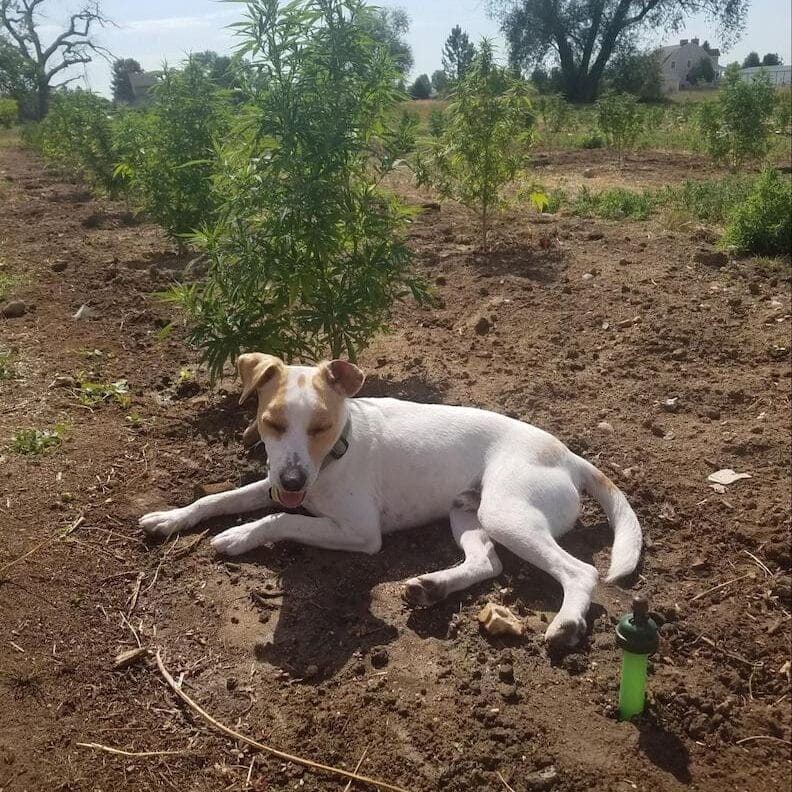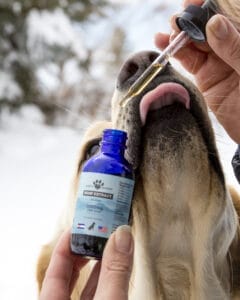In the intricate world of canine physiology, one system, in particular, stands out due to its profound implications for our furry friend’s overall well-being: the endocannabinoid system (ECS). Just as in the human body, the ECS in dogs helps maintain the general health of all ages and breeds. Gaining insights into how compounds from the hemp or marijuana plant enhance physical and mental well-being can provide a clearer perspective on how CBD works in the body.
The Endocannabinoid System and The Cannabis Plant
The endocannabinoid system is found in all mammals, even if they have never been exposed to cannabis plants. This system produces endogenous compounds that work alongside those found in Earth Buddy’s organic hemp extract. It is responsible for supporting sleep, appetite, discomfort, mood, the central nervous system, and the immune system, among other bodily functions.
Naturally occurring cannabinoids are consistently identified in various chemical pathways throughout our bodies. The endocannabinoid system consists of receptors scattered throughout, with the highest concentrations in the digestive system and brain (central nervous system).
Activation of the endocannabinoid system, whether through natural processes or from plant-derived cannabinoids, prompts pathways to restore balance and address dysfunction. But as pets age, the endocannabinoid system can become deficient, which is why many pet parents notice a difference in their pets when they begin a CBD regimen.
Before we dive deeper into how CBD works to promote and support long-term health, you first need to get a general understanding of what the endocannabinoid system entails.
Endocannabinoids in the Dog’s Endocannabinoid System
Endocannabinoids, the body’s naturally produced or endogenous cannabinoids, are vital components of the canine ECS. Similar to their role in human physiology, endocannabinoids in dogs modulate a myriad of biological processes. The primary endocannabinoids identified in all mammals, like dogs and humans, include:
- 2-Arachidonoylglycerol: Predominantly found within the central nervous system, 2-AG in dogs contributes to mood stabilization, appetite regulation, and certain immune responses.
- Anandamide: Commonly known as the “bliss molecule,” anandamide regulates several processes in dogs, including mood enhancement, pain modulation, and appetite stimulation.
These lipid-based neurotransmitters interact seamlessly with specific receptors spread throughout a dog’s body to mediate various physiological responses. They can bind to either receptor. The results of the interaction depend on where the receptor is located and which endocannabinoid it binds to.
Enzymes in the ECS
Once these molecules have served their purpose, it’s essential that they be swiftly degraded to prevent prolonged activity. Specific enzymes are tasked with breaking down these endocannabinoids, including FAAH and MAGL. Each of these enzymes has its own specific action to be carried out.
Fatty Acid Amide Hydrolase (FAAH) and Anandamide
FAAH is the primary enzyme responsible for degrading anandamide. By breaking down anandamide, FAAH helps regulate the concentration of this endocannabinoid in the body, ensuring that it doesn’t overstimulate the ECS receptors and disrupt the system’s balance. Inhibiting FAAH and thus increasing anandamide levels has been considered a potential therapeutic strategy, given anandamide’s role in pain modulation, mood regulation, and other physiological processes.
Monoacylglycerol Acid Lipase (MAGL) and 2-AG
MAGL is the main enzyme accountable for the hydrolysis of 2-AG into arachidonic acid and glycerol. This degradation is vital for the termination of the biological actions of 2-AG. Like FAAH, inhibitors of MAGL have been studied for potential applications, given the role of 2-AG in neuroinflammation, neurodegeneration, and other central nervous system functions.
Receptors in the Dog’s Endocannabinoid System
The ECS in mammals, including dogs, works by interacting with two primary receptors known as CB1 and CB2.
- CB1 receptors: Found abundantly in the brain and central nervous system of dogs, CB1 receptors also have a presence in other parts of the body, including the heart and digestive system. They play a central role in mood, memory, and overall neurological function.
- CB2 receptors: Located mainly on immune cells, peripheral nervous system, and certain peripheral organs and tissues, CB2 receptors are integral for immune system modulation and the regulation of inflammatory responses in dogs.
The engagement of endocannabinoids with these cannabinoid receptors ensures that our canine companions remain balanced and responsive to environmental stimuli.
The Role of the Canine Endocannabinoid System
The overarching importance of the ECS in dogs lies in its ability to promote homeostasis. Whether it’s modulating pain after an injury, regulating appetite, or influencing sleep patterns and mood, the ECS is invariably involved.
Endocannabinoid Deficiency Found in Clinical Trials
Endocannabinoid deficiency in dogs refers to the idea that sometimes dogs might not have enough of certain natural chemicals in their bodies. These chemicals help keep everything balanced, much like how a thermostat maintains a room’s temperature. When dogs don’t have enough of these endogenous cannabinoids, they might experience health complications.
Just like some people believe that humans can have this deficiency, there’s a thought that dogs can as well. Observations have indicated that certain canines with specific health challenges might exhibit reduced levels of these crucial cannabinoid signaling pathways.
How CBD Oil Works on the Brain
Cannabidiol or CBD oil for dogs and cats influence on the brain is subtle, affecting a range of receptors and neurotransmitter systems. The most noticeable impact involves CBD’s affinity for the 5-HT1A serotonin receptors, which plays a role in enhancing your pet’s brain function. By influencing this receptor, CBD might help maintain normal nervous system function. In addition:
By working with neurotransmitters in the brain, full-spectrum hemp extract:
- Enhances brain function
- Promotes normal healthy brain activity
- Supports normal oxygen utilization by the brain
- Helps to balance normal serotonin levels
By enhancing GABA signaling, full-spectrum hemp extract:
- Helps dogs maintain a normal and relaxed disposition
- Helps maintain contentment during separation, travel, motion sickness and tension caused by changes in your pet’s daily routine
- May reduce hyperactivity and promote relaxation
How CBD Oil Works to Support the Immune System
The ECS plays a crucial role in promoting homeostasis in the body. CBD’s interaction with the ECS, particularly CB2 receptors, can help maintain a normal inflammatory response. While CB2 receptors are widespread in immune cells, the exact mechanisms through which CBD impacts them in the context of immune function in dogs still require further research. However, scientists have discovered:
By interacting with CB2 receptors, which are primarily found in immune cells, full-spectrum CBD oil for dogs and cats may help:
- Maintain a normal inflammatory cytokine cascade
- Enhance liver and kidney functions
- Promote the body’s innate resistance to pathogens
- Support normal detoxification processes
CB2 receptors may also promote apoptosis when combined with full-spectrum hemp extract. Apoptosis is a process where cells undergo a programmed death when they are damaged or no longer needed. The compounds in CBD oil for dogs and cats may promote the apoptosis of immune cells that are dysfunctional or potentially harmful, expelling cells that may be detrimental to the body.
How Full-Spectrum Hemp Extract Affects Levels of Discomfort
When CB1 receptors are activated, CBD for dogs and cats may help with occasional discomfort. CB1 receptors work alongside the TRPV1 receptor and may also enhance endocannabinoid levels, particularly anandamide, which may:
- Help discomfort associated with normal daily exercise and activity
- Ease aches and discomfort caused by training and competition
- Supports animals with joint tenderness due to everyday activity
How CBD Works to Promote Digestive Health
The gastrointestinal tract is full of CB1 and CB2 receptors, but CB2 receptors outweigh CB1 in this area of the body. CB2 receptors are primarily found in the gut, immune system, liver, and pancreas.
Since full-spectrum hemp extract aids in bringing the body back to homeostasis, it may also support a normal inflammatory response in the gut through interaction with CB2 receptors, which helps support healthy GI function. More potential health benefits of this interaction include:
- Assisting in the digestion and absorption of essential nutrients
- Helping maintain proper gut flora
- Supporting normal bowel function
- Helping support the protective layers of the bowel
- Supports inflammatory pathway signaling in the gut
How Long Does CBD Take to Work on Dogs?
CBD’s effects on dogs can be diverse and individualized. There isn’t a one-size-fits-all answer to how long it will take to determine the best dosage for any individual pet. Its efficacy is contingent upon each pet’s unique physiology and the specific concern being addressed. It’s advisable to adopt a patient and methodical approach, beginning with a low dose and adjusting the dosage as-needed.
To determine if the current amount is helping, start with the recommended dosage on the product’s label and maintain this for about a week or slightly longer. If you observe positive changes, maintain that dosage. If no significant changes are evident, consider a gradual increase, and then observe your pet for another week or so. Continue this process until you have found the lowest effective dosage.
Assessing the oil’s effectiveness involves closely observing your pet’s behavior, digestive health, and overall demeanor, since our furry friends can’t verbally express how they feel. Keeping a detailed journal can be helpful, documenting even minor differences. Remember, every dog and cat is unique; factors like weight, age, size, and breed can influence how much CBD they might need.
Looking Into Hemp Derived CBD Products
In the highly unregulated industry of dietary supplements, approved nonprescription pet CBD products aren’t based on a governing agency. The only true guideline is that CBD for dogs and cats must remain under 0.3% THC. That’s what makes CBD legal according to the controlled substances act. Aside from this, there isn’t any required documentation (unless it’s medical cannabis), and any company can claim their product, like their hemp derived CBD, has the same benefits as others.
Earth Buddy utilizes full-spectrum hemp extract in all products, highlighting the commitment to offering a comprehensive and synergistic hemp experience. To verify the contents of each product, lab results are available from a third-party lab. This is a document every prospective customer should look for prior to making a purchase.
Full-spectrum CBD oil for dogs and cats is critical to ensuring hemp derived CBD will work to the best of its ability. Full-spectrum hemp products maintain as many of the original compounds as possible, including THC and CBD, to achieve optimal results when acting together. This results in what has been coined the entourage effect.
Without a full-spectrum formulation, the all-encompassing benefits of the entourage effect may be compromised. This effect is a harmonious interaction between various compounds present in the hemp plant, including CBD, CBG, CBDa, THC, terpenes, and other inherent components, collectively contributing to the product’s efficacy. Simply put, the combined synergy of the whole plant’s extract is more potent than the sum of its isolated parts.
On the other hand, broad-spectrum CBD products and pure CBD isolates have been processed more rigorously, removing many of the intricate compounds that enhance the endocannabinoid system’s function. The depletion of these compounds might diminish the product’s overall potency. Hence, with broad-spectrum variants, the primary concern shifts from how long and which dosage is necessary to notice the effects to whether it will work at all.
General Dosing of Hemp Derived CBD Products from Earth Buddy
Starting your pet on a CBD regimen is a journey of discovery, as there’s no one-size-fits-all approach or a standard calculator to determine the perfect dosage for your individual pet. While the amount of CBD oil for dogs and cats required might not be instantly clear, the good news is that extensive testing has shown CBD to be relatively safe for pets. In instances where they might consume more than needed, the most prevalent side effects observed have been lethargy or diarrhea. It’s worth noting that pets, like humans, can have varying sensitivities to CBD.
The aim should be to pinpoint the minimal dosage that yields noticeable benefits. Typically, the suggested dosage hinges on the pet’s weight. Earth Buddy, for instance, advises a dose of 1-3 mg for every 10 pounds your pet weighs to start. If you’re using a tincture, the most widespread method is direct oral administration using a dropper or pipette. For potentially faster absorption, consider applying the tincture to the pet’s gums, allowing the capillaries there to soak up the extract.
For longer lasting and optimal benefits, we suggest administering CBD treats or CBD oil for dogs and cats with foods high in fat. Although mixing in food may take longer for CBD to take effect, it will increase absorption ultimately improving the overall efficacy.
For more information on how much CBD to give dogs and cats, check out our dosage page here
Treats Containing CBD Oils Could Take Longer
When administering full-spectrum hemp plant extract to your dog via treats as opposed to a tincture, you might notice a longer wait time before observing any effects. The direct tincture method allows the compounds to swiftly interact with the endocannabinoid system via the bloodstream. In contrast, when given as a treat, it needs to undergo the digestion process first.
If your pet isn’t willing to allow the tincture on their gums or in their mouth at all, CBD products in treat form do offer a viable alternative. Just remember, it may take longer in edible form. This delay arises because the CBD in the treats has to be processed by your dog’s digestive system before entering the bloodstream.
For further reading, we recommend:
- https://www.ncbi.nlm.nih.gov/pmc/articles/PMC2241751/?_ga=2.147950452.2125947152.1681494125-1113979084.1681494125
- https://pubmed.ncbi.nlm.nih.gov/24923339/
- https://pubmed.ncbi.nlm.nih.gov/18446159/
- https://www.ncbi.nlm.nih.gov/pmc/articles/PMC8803256/
- https://www.ncbi.nlm.nih.gov/pmc/articles/PMC4789136/
- https://www.ncbi.nlm.nih.gov/pmc/articles/PMC5333598/
- https://www.ncbi.nlm.nih.gov/pmc/articles/PMC4940133/
You Might Also Enjoy
Your dog’s skin is their largest organ making dog skin care a crucial part of…
Like us, our dogs, and other mammalian species, cats have an endocannabinoid system. This system…
Learning how to calm a dog down is an essential skill to have in your…








